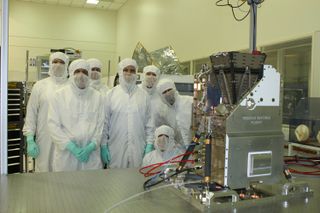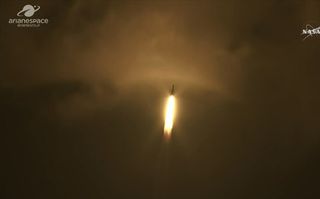NASA GOLD, 2 Satellites in Orbit After Ariane 5 Launch Anomaly (Update)
Update for 9:17 pm ET: Read our full story on tonight's launch anomaly and orbital success for NASA's GOLD instrument, SES-14 and Al Yah 3 here: Ariane 5 Rocket Delivers Satellites, NASA GOLD to Orbit Despite Launch Anomaly
Update for 8:47 pm ET: Arianespace representatives have reported that the SES-14 and Al Yah 3 satellites are in their expected orbits after the company lost contact with its Ariane 5 rocket's upper stage during tonight's launch. Here's the latest statement from Arianespace:
"The launcher’s liftoff took place on January 25, 2018 at 7:20 pm. A few seconds after ignition of the upper stage, the second tracking station located in Natal, Brazil, did not acquire the launcher telemetry. This lack of telemetry lasted throughout the rest of powered flight. Subsequently, both satellites were confirmed separated, acquired and they are on orbit. SES-14 and Al Yah 3 are communicating with their respective control centers. Both missions are continuing."
Arianespace CEO Stephane Israel delivered a statement regarding the anomaly via the launch webcast (video above). That statement is as follows: "Ladies and gentlemen, I come to give you some information because we have had an anomaly on this launch. Indeed, we lost contact with the launcher a few seconds after ignition of the upper stage. At that time, we can consider that the upper composite and the satellite as being (inaudible). But as I said, we lost contact. Up to now, our customers do not have contact with the satellite. We need now some time to know if they have been separated, and where they are exactly, to better analyze the consequences of this anomaly. I want to present my deepest excuses to our customers, who have entrusted us one more time. We know that there is no launch with no risk. We know that launch is always difficult, and tonight Ariane 5 has had an anomaly, so lets take time now to better understand the situation of the satellites. Arianespace, in full transparency, will come back to you to provide you with some more information as soon as we have them. I apologize on behalf of Arianespace."
Our original launch story appears below:
An eagle-eyed NASA instrument, built to study the boundary between Earth and space, hitched a ride to space today (Jan. 25) with a new communications satellite that launched into orbit on a European rocket.
The Global-scale Observations of the Limb and Disk (GOLD) instrument, somewhere between a microwave and minifridge in size, lifted off with the SES-14 telecommunications satellite on an Ariane 5 rocket from Guiana Space Center in French Guiana. Another communications satellite, called Al Yah 3, launched on the same rocket. [NASA Goes for 'GOLD' to Scan the Border of Earth and Space]
Get the Space.com Newsletter
Breaking space news, the latest updates on rocket launches, skywatching events and more!
"GOLD is a true pathfinder for NASA in several ways," Elsayed Talaat, the heliophysics chief scientist at NASA headquarters, said in a teleconference yesterday (Jan. 24). "This is the first time that NASA's flown a science mission as a hosted payload on a commercial satellite … [and] we anticipate that having GOLD up there will give us new insight into the upper atmosphere that will revolutionize our understanding of space weather."

Living on the edge
After launch and separation from its rocket, SES-14 and GOLD will begin to use electric propulsion to transfer into the satellite's final, geostationary orbit — a high spot in space where its circling keeps it centered above one spot on Earth as the planet turns. (It's headed to an orbit of 22,000 miles, or 35,400 kilometers, above Earth; for comparison, the International Space Station circles at about 250 miles, or 400 km above the surface.) From there, it will be able to track the temperature of nearly a whole hemisphere's ionosphere and thermosphere, giving scientists invaluable data to build models of the complicated region near the top of Earth's atmosphere.
"Part of the problem with this region is it's constantly changing — it can change very rapidly," Richard Eastes, principal investigator for GOLD and a researcher at the University of Colorado Boulder's Laboratory for Atmospheric and Space Physics (LASP), which built the instrument, said during the teleconference. "The temperatures there can change by hundreds of degrees in just an hour, but we haven't been able to really track this very well."
Conditions in the upper atmosphere, which vary based on particles and radiation coming from the sun as well as weather patterns on Earth, are poorly understood. But this information is critical to communications and navigation systems, because radio waves bounce off of the atmosphere, and satellite-Earth communications (and GPS signals) must pass through it.

In addition, space weather — the sun's variation, changes in Earth's magnetic field and changes in near-Earth space — can disrupt electric power systems and grids on Earth in severe cases, Talaat said. The better scientists can understand and model the region, the better they can monitor and predict the effects it will have on Earth and low Earth orbit.
"This is a really incredible region where terrestrial weather from below percolates up and mixes with solar influences like geomagnetic storms and solar extreme ultraviolet radiation from above," said Katelynn Greer, a research scientist at LASP. "With GOLD, we're going to be able to get to observe this with measurements of temperature and composition on the whole disk [nearly a whole hemisphere of Earth] every half-hour. And we've never had information like this before."

Coming online
SES-14 and GOLD will take about 4 and a half months to maneuver to their high perch in geostationary orbit using electric propulsion, the researchers said. After that, the satellite, and then GOLD, will run checks to make sure everything is in order. All told, it should be "September-ish" before observations start coming down.
But there's one key moment that will take place just a few days after launch, according to Susan Batiste, a systems engineer at LASP.
"We do have an opportunity where we're going to turn on the instrument and send a few commands," she said during the teleconference. GOLD's highly specialized detectors can't be surrounded by air; they can only be in nitrogen or a vacuum, she said. After launch, the GOLD team will allow the instrument to open its detector doors and expose them to the vacuum of space for the trip up into geostationary orbit.

"It's a very rough ride through launch, and this will be just a nice feeling to know, yes, it made it through launch; we can turn this guy on and open the doors; then we can sit back and relax while SES and Airbus [Defense and Space, which built SES-14] do their thing getting this spacecraft up into geo[stationary] orbit," she said.
It's just one of many benefits of placing NASA science instruments as a hosted payload on a commercial satellite — and although GOLD is the first, NASA officials anticipate that more will follow that route. (One other mission, called GeoCARB, is also set to launch with a commercial satellite.)
"Being on hosted commercial satellites gives us, NASA, a new cost-effective tool in our toolbox for doing science," Talaat said. "There are still many times when we would have to build the satellite and do the launch ourselves, but the more tools we have to get into space, the better for our overall science program."

Email Sarah Lewin at slewin@space.com or follow her @SarahExplains. Follow us @Spacedotcom, Facebook and Google+. Original article on Space.com.
Join our Space Forums to keep talking space on the latest missions, night sky and more! And if you have a news tip, correction or comment, let us know at: community@space.com.

Sarah Lewin started writing for Space.com in June of 2015 as a Staff Writer and became Associate Editor in 2019 . Her work has been featured by Scientific American, IEEE Spectrum, Quanta Magazine, Wired, The Scientist, Science Friday and WGBH's Inside NOVA. Sarah has an MA from NYU's Science, Health and Environmental Reporting Program and an AB in mathematics from Brown University. When not writing, reading or thinking about space, Sarah enjoys musical theatre and mathematical papercraft. She is currently Assistant News Editor at Scientific American. You can follow her on Twitter @SarahExplains.
